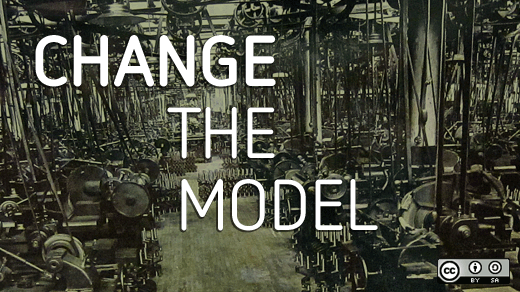The Opensource.com team asked if I'd share some of my thoughts about The Open Organization, seeing as I'm quoted in the book.
I suppose it's rather fitting that I'm mentioned twice in the book, because that's how many times I've worked at Red Hat: initially from 2005 to 2007 (my first "real" job after college) and again from 2012 to the present. In the interim, I happened to write an article for Opensource.com, which ultimately ended up quoted in the book (on page 94).
It's fascinating to read that article five years later, because it shows me just how much both my own thinking and Red Hat's has evolved.
Red Hat, circa 2005
When I first worked at Red Hat, we were this scrappy little company that was growing insanely fast. We spent a whole lot of energy worrying about becoming one of those giant, soulless companies that sucks the life out of people. There was this radical vision of a very flat structure where managers were almost irrelevant and individuals were ultra-empowered to make decisions. And we tried a lot of unusual experiments to achieve that... some quite similar to what Zappos is exploring now, as a matter of fact.
Most of those ideas didn't really pan out, but it didn't matter all that much, because we had a great culture and a strong sense of shared purpose and people were already empowered to make their own decisions, even if we weren't sure that we could sustain that as we grew.
Then and now
Long story short, I was in my early 20s and just didn't fully get how great this company was, and I left Red Hat for about five years. By the time I returned in 2012, Red Hat had really hit its stride, and in more ways than one. We were still the same company that I'd joined back in 2005, only now we were poised to become the first open source company to reach a billion dollars in annual revenue.
In many ways, we were living the best parts of the same culture that we'd always had, and we'd come to realize that we didn't need a magical organizational structure or radical policies to sustain it. It might sound a little Wizard of Oz-esque, but I believe that all along, we'd always had what we needed: the principles that make open source communities successful (meritocracy, purpose, passion, collaboration, and more). Those are what makes Red Hat an engaging and rewarding place to work. That was as true in our early days as it is today.
Meritocracy in action
The second time I'm mentioned, it's a few pages later, in the chapter about meritocracy. And it's a fun example of what I love most about Red Hat: the openness that so many Red Hatters (Jim chief among them) have to ideas, regardless of their source. My words were originally just an observation I'd scribbled in the margin of an early draft, one of many spots where I flagged something as either "Yes! That's so true..." or "Eh... I can't say as I agree with how this is written." So I just about fell out of my chair when, the next time I saw the draft, one of those notes had been turned into a quote:
At Red Hat, we encourage associates to work on what interests them and then watch what happens when they put their energy and talent into their work, whatever their role. "In any job, there are those projects that look like some small, boring things to check the box on," says Rebecca Fernandez. "But at Red Hat, there are so many opportunities for you to rethink those kinds of projects and say, 'No, this is bigger than what you're suggesting, there's an opportunity here to do something more valuable,' and maybe take that project in an entirely different and better direction." That kind of meritocratic freedom to run with your ideas is where some of our best work happens, and is some of the most gratifying.
That really is the magic of working in an open organization. People are open to feedback, and you get the chance to influence projects that you'd never be involved with in a conventional organization.
How I got involved in the book
Now, you might be wondering how I came to be in possession of an early draft of the book, let alone why I was scribbling my own thoughts in the margins. I came into the project fairly late, and it was thanks to my then-manager, Kim Jokisch. Before the book, I'd only ever spoken to Jim once or twice (read: in an elevator). But Kim had some stories about working at Red Hat that were in early drafts, and she was part of the book review team. When she got the first draft, she shared it with me and said that if I had any feedback, she'd add it to what she gave to Jim. She warned me that she had to send her own feedback in the next day or two, so I probably wouldn't have time to read the whole thing.
I started to read the draft and was immediately hooked. I ended up pulling an all-nighter. Actually, it might have been two. Because let's be real: who would miss the opportunity to contribute to something like this?
Open leadership
When Kim looked at my notes and edits, she said, "You know what? You need to be on this review team. Let me see what I can do."
She said as much to Jim, but I knew that at Red Hat, there are tons of very smart people, and they can't all help with every project, or you'll never get anything done. The book was already in very capable hands, so I wasn't really expecting to be invited to join that group. I was satisfied that Jim had been given my feedback, and I hoped that he found something helpful in it. Also, my comments were pretty darned tough in some spots, so I wasn't necessarily relishing the thought of getting into a room and discussing them with people who'd put long hours into the draft!
But Jim was very open to all of what I'd written, and he gave each item due consideration. A few weeks later, I found myself sitting in a room with Jim and some of the smartest people in the company, who were debating the latest version of the draft. Pretty surreal, all in all, but it's not that unusual for Red Hat. Just another example of life in an open organization.
What I learned from the book
Even after all these years of working at Red Hat, I still took away some new ideas from The Open Organization. The biggest was that it's easy to see the risks in having a company culture where challenging opinions and assumptions is encouraged, but until I read this book, I hadn't really grasped that there's just as much (if not more) risk in having a culture of "terminal niceness," where people don't want to rock the boat.
What I hope others will take away
In an open organization, everyone may have a say, but they don't all get a vote. If you're a decision-maker, work hard to seek out many different perspectives, because no matter how much of an expert you are, those conversations will help you make better decisions.
You probably won't please everyone, and that's okay. Just be transparent about what's happening, and do your best to explain why.
Follow the conversation on Twitter #theopenorg






Comments are closed.